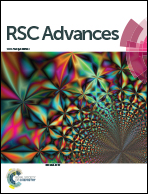Mechanism for anomalous luminescence behaviour of Eu2+-doped red-emitting magnesium nitride phosphors
Abstract
A series of novel red-emitting phosphors Mg3−xN2:xEu2+ (0 ≤ x ≤ 0.08) were successfully synthesized by solid-state reactions at low temperature. The grains of the resulting phosphors showed good dispersibility with diameters of about 14–20 μm; some needle-like crystals gradually increased in length and thickness as the sintering time increased. The excitation spectra of the Mg3N2:Eu2+ phosphors showed strong excitation in the range 250–450 nm, with a dominant excitation peak around 428 nm. At excitation wavelengths <428 nm, the phosphors exhibited a broadband red emission peaking at about 612 nm with a tail on the long wavelength side. The emission peak positions of the Mg3−xN2:xEu2+ (0 ≤ x ≤ 0.08) phosphors shifted from 621 to 609 nm as the Eu2+ concentration increased and the emission intensity was at a maximum at x = 0.05. The mechanism of the shift in emission was explained by adjusting the cationic composition of the phosphors. The emission peaks of Mg3N2:Eu2+ were influenced by the nephelauxetic effect, the crystal field environment and the Stokes shift. Based on experimental data, we propose an underlying mechanism of thermal quenching and elucidated the large thermal quenching of Mg3N2:Eu2+ using a configurational coordinate diagram. These results indicate that Mg3N2:Eu2+ could be used in the development of white light-emitting diodes.


 Please wait while we load your content...
Please wait while we load your content...